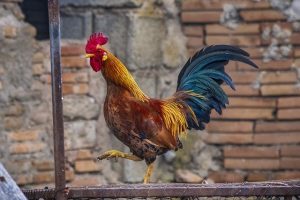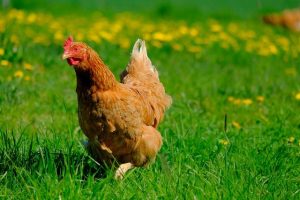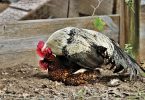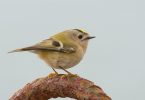Hen vs Rooster
In this article, we will be sharing the difference between rooster vs hen. Although the focus is on the differences but we will also look at the similarities that they share.
The chicken mammal or bird is one of the most domesticated animals or mammals in the world. People domesticate the different species of the mammal for different reasons, some of which could be or include the following: for commercial purposes and for food. People could domesticate the chicken animal because they intend to sell the stock, either as a live chicken or as a frozen product, some domesticate it to sell the eggs.
In the time past, or rather in the early days of historic life (when human started taking accounts of events) chickens were mostly raised for mostly special ceremonies and also for cock fighting, but barely for food. Chickens were raised for food at the time, until the Hellenistic period (that is between the second century and the fourth century). So in these days, humans keep chickens mostly as a source of food (consuming both their eggs and meats) and sometimes pets just like we already established earlier.
More so, chickens could be domesticated for the purposes of food. Like they could be domesticated because the owners want to feed on them or feed on their eggs.
The chicken is an omnivorous animal, so while in the wild, the omnivorous animal often scratches the soil in search of food so it feeds on seeds, on insects and even on some animals as large as the lizards, small snakes, and even young mice.
It is necessary to state in this section that the average chicken whether male (cock) or female (hen) and regardless of the breed or species have been observed to only live for about five years to ten years, only that the years for each chicken are depending on the breed.
In a Guinness world record show, it is recorded that the world’s oldest chicken died at sixteen years.
However, in this article we will be looking at the rooster vs hen. We will be looking at their similarities, as well as their differences.
Description of the Chicken
Before we proceed to knowing the differences between the rooster vs hen, it is important that we describe the chicken, and we will do so by describing them according to gender or manner in which we will be discussing them in this article.
Description of The Rooster

The male chicken mammal is called or identified as cock or rooster. More so, it is necessary to note that the rooster or the cock is a term rightly and mostly used for the adult male bird called or often identified as the chicken. and younger male may be called cockerels. If for any reason a male chicken is castrated, it is called a capon.
In a coop of chicken, it is usually easier to identify the adult roosters from adult hens that are around them. More so, roosters also develop very unique traits that often help the roosters attract the hens as well as protect the flocks around it. This is very visible especially if you observe the roosters as they develop.
Generally, the different species of roosters are known for their big and fleshy red combs, as well as their tail that can be more than about thirty centimeters (30 cm), and twelve inches (12 inches) in length. Apart from the roosters’ very striking plumage of lengthy flowing tails, different species of roosters or cocks can also be, and are usually differentiated from different species of hens by the cock’s very shiny and very pointed feathers on the neck of the rooster, and on the back of the rooster.
The shiny and pointed feathers on the neck of the rooster are called the hackles, while the shiny and pointed feathers in the back of the rooster are called the saddle. More so, these very shiny and pointed feathers on the neck (hackles) and on the back (saddle) actually have colours that are way brighter, and way bolder than the colours of the feathers of the females of the same breed or species.
More so, in some other species of chicken or breeds of chicken, a breed like the Sebright chicken, the neck of the rooster is only a slightly pointed feathers on the neck (slight hackles), but it has the same colour of feathers just as the colour of feathers of the Sebright hen.
So in species of chicken or breed of chicken like the Sebright chicken, the identification or differentiation of the female breed of Sebright species from the male breed of the Sebright species, can only be successfully made by looking at the comb of the female Sebright species or breed and the comb of the male Sebright species or breed. The difference between the male Sebright breed and female Sebright breed can also be spotted eventually through the observation of the development of spurs on the legs of a male Sebright breed.
However, there are still few breeds that have a different case. For instance, in certain hybrids, or breeds of chicken, the male chicken and the female chicken can be and mostly differentiated by the colour of the male breed and the colour of the female breed.
We will take a more comprehensive look at the description of the roosters by picking the features one after the other.
Combs and Wattles
At a glance we know that breeds of chickens irrespective of the breed’s gender have a comb on its head, and a pair wattles beneath its beak. We have also identified the rooster by its comb in one of the preceding sections, we will be more specific here.
The comb of the chicken is red in colour, it is a fleshy organ and it sits like a crown on the head of the chicken. Also, the wattle of the chicken is similar to the comb, it is red in colour, it has a fleshy growth under the beak of the chicken.
On the head of a rooster, the comb is bigger, and the red colour is brighter, and beneath the beak of a rooster, the wattle is bigger, and the colour is also brighter. The comb and wattle are well utilized by roosters, perhaps that accounts for why they have bigger and brighter combs and wattles. This assumption is true because the roosters use the large, and very colorful combs and wattle growths to get the attention of hens they want to mate with.
Spurs
We had mentioned spurs in one of the preceding paragraphs without clearly explaining them, we will explain them here. So, spurs are the sharp bone growths that usually sprout from the legs of the rooster.
Spurs however, can be removed by a surgeon, yet most chicken owners prefer to leave the spurs on the leg of the rooster, some others try to manage or control the spurs by filing it down or trimming it down its sharp ends. Spurs are also a natural method roosters use to defend itself from both its predators and its challengers for its role in the flock. Roosters can really do a huge amount of damage by merely using the spurs.
Crowing
One of the duty nature has given the roosters is duty of crowing. So among the flock of chickens, the roosters are the only group saddled with the duty of crowing irrespective of the breed or species of chicken. However, the crow of the roosters usually come as an announcement of dawn to the neighborhood especially as the sun is set to rise.
Apart from crowing to alert the neighborhood, the cock also crows for a whole lot of other reasons. Sometimes, the cock could crow to get attention of the hens, the cock could also crow to cheer the flocks, or sometimes to show off. Again, the cock can also crow to alert the flock of chickens of a predator that is trying to invade or harm the flock.
Leg Size
Another distinct feature of the cock, is in the size of its leg. The male chickens will or the roosters have very thick legs, legs that are thicker than those of the female counterparts (the hens). More so, in some other breeds, the roosters grow quite pointed, and sharp spurs (we talked about the spurs before) on their legs just above their toes. When a rooster is six months old, the spurs of the rooster is usually less than one third of an inch in length, and the older the rooster gets, the longer the spurs of grow.
Description of the Hen

Egg
You may find it weird that we are starting to describe the hen or the pullet (baby hen) from the eggs. It is easy to identify the hen from a flock of chicken by carefully looking at the eggs. This is only possible when you are the breeding the egg to be hatched, and not buying chicks. You can discover which egg is a hen by carefully examining the shape of eggs.
So for starters, while examining the eggs, the piece of egg that has a sharp looking and a pointed tip are more likely to be rooster eggs, and will in fact be a cockerel when it hatches, and become a rooster when it grows. On the other hand, while examining the eggs, the piece of egg that is round in shape is more likely to be hen eggs, this means that when the egg hatches, a pullet will be hatched, and the pullet will grow to be a hen.
However, it is important to know that this particular method may not always be reliable.
Egg Laying
Another way of identifying the gender of the chicken is by observing which chicken lays eggs in the flock. So any chicken that lays egg in the flock is the hen. Or rather the group of chickens that lay egg, are hens.
Feathers
We have in the preceding paragraphs identified that the feathers on the neck are called the hackle feathers, while the feathers on the back are called the saddles. So the feathers of the hen are not very colorful neither are they longer. The hackles of the hen are rounder and are shorter.
So even as pullets, they will still have rounded hackles. In addition to the feathers of the hen, the hen has a set of its own tails too. They are not as long as those of the roosters, although they are high-arched tails.
Combs and Wattles
Roosters have combs and wattles, and so do the hens (the female chicken). So the hens despite their breeds have combs that are like crowns on their head. The combs are red and fleshy but not very bright red, neither are they as big as those of the comb of the roosters. The hen also has wattles, its lobed wattles also hang below the beak of the hen, and are not as big as those of the roosters.
A few facts about the chicken
-
Muff mutation
So a muff mutation is also known as a beard mutation. This is a kind of mutation that is found in so many breeds of chicken, almost all breeds of chicken which is responsible for the extra feathering in the face of the chicken or rather under the chicken’s face, which gives it the feeling as well as the looks of a beard.
-
No Long Distance Flights
That sound of this caption or subtitle could be like a warning. However, it is a warning especially for domestic chickens, because domestic chickens do not have the ability of participating in a long distance flight. This does not mean that the domestic chicken cannot fly, it is that domestic chickens cannot fly to certain heights.
Notwithstanding, the lighter and younger chickens are generally capable of flying a little higher and fly more distances than the adult domesticated chickens that crow on the ground. Like they could fly over the fences, they could fly into trees, (where they could naturally roost).
However, generally chickens could attempt to fly occasionally just to briefly explore their environments, and they generally do so, so they flee as soon as they perceive any form of danger.
-
Unity in Battle
Chickens could be solitary sometimes especially in the face of an unsuspecting predator, or a predator that seems weak.
So, a flock of chicken can sometimes gang up on a predator that is weak, or gang up on a predator that has little or no experiences. There is a story that some flocks of chickens killed a young fox. There is also another verified story that a flock of chickens, hens precisely attacked a hawk that invaded their coop.
-
Puffed Feathers
When a chicken, whether a hen or a rooster, finds itself in a situation where it is threatened by a seeming predator, the feathers puff up. When a chicken is stressed, or is sick, there is a huge tendency that the chicken will have to puff up its feathers. It is the chicken’s way of expressing how it feels, or reacting to the stimuli it perceives around it.
-
Hatching and early life
After hens lay eggs, it takes about twenty-one days for the fertile chicken eggs to hatch. The development and the growth of the chick regardless of its breed starts at the beginning of the incubation period, so all the chicks have the tendency to hatch between one day or two days when it is due.
Before the eggs hatch, the hen while laying around often hears the chicks gently peeping inside the eggs, they calmly cluck on the shell to stimulate the chicks to be able break out of their shells. Ones the chick gets stimulated, the chick begins hatching out by “pipping” and pecking a breathing hole the tooth of its egg.
The tooth is usually on the upper side of the egg which is towards the blunt part of the egg. After pecking for a while, the chick rests for some time, after which it absorbs the remaining yolk left in its shell, and withdraws the supply of blood from the membrane under its shell which it used for breathing earlier. It makes a bigger hole, and it comes out of the shell.
How Do I Know if My Chicken is a Pullet or a Cockerel?
When one gets some chicks, one is not sure of which chick is a pullet or a cockerel and since we are sharing some information about the rooster vs hen, it is also necessary that we share an information on how we to identify a pullet and a cockerel from a flock of chicks.
First, it is best to buy from the hatchery, because the farmer there will be able to help you identify which is a pullet, and which is a cockerel among the flock of chicks.
Apart from that, the truth is that it is not easy to identify a pullet and a cockerel, even with professionals involved. It is also not very good to have to carry out vent sex on the chicks for the purposes of identifying the gender of the chick.
Unfortunately, yet more convenient the best way of finding out if the chick is a pullet or if it is a cockerel, which of them belongs to either gender is simply by waiting around for the chicks to grow. The time you have to wait is depending on the breed or on the species of the chicken or chicks as the case may be.







